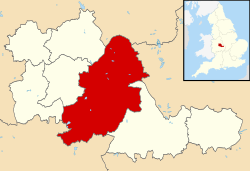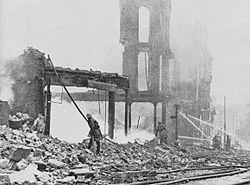Birmingham
Birmingham (/ˈbɜːrmɪŋəm/ (![]() listen)[3] BUR-ming-əm) is a city and metropolitan borough in the West Midlands, England. It is the second-largest metropolitan area and city in the United Kingdom.
listen)[3] BUR-ming-əm) is a city and metropolitan borough in the West Midlands, England. It is the second-largest metropolitan area and city in the United Kingdom.
About 1.1 million people live in Birmingham. Around 4.3 million people live in its metropolitan area.[4][5][6] Many people call it the "second city" of the United Kingdom.[7][8][9]
History
Birmingham began as a small town in 1166. Queen Victoria gave city status to Birmingham in 1889.
Many industries were developed in Birmingham during the 18th and 19th centuries. These included making weapons and food.
Birmingham manufacturing industry played a big role in the war effort in World War I and World War II. The WWII spitfire aeroplane was made in Birmingham. In 2000, a statue of stylised spitfires was erected next to the old factory site. The factory now makes Jaguar cars. Birmingham had a large car making industry. It has declined since the 1980s. It remains the home town for Jaguar and Land Rover cars.
In 1974, twenty-one people were killed in the Birmingham pub bombings.[10]
Transport
Grand Union Canal
Birmingham was an important stagine-post in the Victorian industrial canal system. Today it is the northern terminus of the Grand Union Canal to London. Heavy goods (as coal surely is) are most economically moved on water. No other form of transport is so efficient.
Motorways
The M40 motorway connects to London via Oxford. The M6 motorway also connects Birmingham to London (via the M1) and to the north-west of England and Scotland. Junction 6 of the M6 is also one of Birmingham's landmarks, and probably the most notable motorway junction in the UK, Spaghetti Junction, officially called the Gravelly Hill Interchange. Other motorways are:
- The A38(M) which links Spaghetti Junction to the city centre
- The M5, connecting Birmingham to the south-west of England
- The M42, which connects Birmingham to Tamworth and the East Midlands
- The M6 Toll, which enables through traffic on the M6 to bypass Birmingham and Wolverhampton.
Birmingham, unlike London and Manchester, does not have a single orbital motorway. Instead, three motorways form a box which surrounds most of the city. These are:
- The M42 to the south and east. In the middle, the M40 ends. It has priority for traffic going from the M40 to the M42 west. The M40 goes off south to Warwick, Oxford, High Wycombe, Uxbridge and London.
- The M5 which forms the western section.
- The M6 which forms the northern section. The M5 ends on the M6.
Other major roads passing through Birmingham include:
- The A34 from Manchester to Winchester
- The A38 from Mansfield to Bodmin
- The A41 from London to Birkenhead
- The A45 from Birmingham to Thrapston (formerly to Felixstowe)
- The A47 from Birmingham to Great Yarmouth
- The A4540 'Middleway' ring road
- The A4040 Outer Ring Road
Famous people from Birmingham
- Gabriel Agbonlahor, footballer
- Geoff Bunn, artist
- Geezer Butler, musician and Black Sabbath member
- Jasper Carrott, comedian
- Tony Iommi, musician and Black Sabbath member
- Jeff Lynne, musician and record producer, co-founder of Electric Light Orchestra
- Bill Oddie, television personality
- Ozzy Osbourne, singer, and Black Sabbath member
- James and Oliver Phelps, actors, famous for playing Fred and George Weasley in the Harry Potter film series
- J.R.R. Tolkien, author
- Julie Walters, actor
- Steve Winwood, musician
- Richard Hammond - Motoring journalist, TV presenter
- Jude Bellingham
Famous pop and rock groups from Birmingham
- Black Sabbath, heavy metal rock group
- Dexys Midnight Runners, pop group
- Duran Duran, pop group
- Electric Light Orchestra
- Judas Priest, rock group
- Moody Blues, pop group
- Ocean Colour Scene
- The Move, pop group
- UB40, pop group
- Wizzard, pop group
Birmingham Media
Matthew Boulton, a prominent early industrialist
The Soho Manufactory of 1765 – pioneer of the factory system and the industrial steam engine
Thomas Attwood addressing a 200,000-strong meeting of the Birmingham Political Union during the Days of May 1832 – oil on canvas by Benjamin Haydon (c. 1832–1833)
Ruins of the Bull Ring, destroyed during the Birmingham Blitz, 1940
The Council House, headquarters of Birmingham City Council
Victoria Square, with the Octagon
References
- ↑ "2011 Census: Key Statistics for Local Authorities in England and Wales". ONS. Retrieved 25 December 2012
- ↑ 2.0 2.1 "Global city GDP 2014". Brookings Institution. Archived from the original on 4 June 2013. Retrieved 18 November 2014.
- ↑ "Birmingham". Wordreference.com.
- ↑ "POPULATION OF BIRMINGHAM 2017 (UK)". Country Digest. Archived from the original on 2 October 2018. Retrieved 2 October 2018.
- ↑ "Population and Census". Birmingham City Council. 7 July 2014. Archived from the original on 26 November 2015.
- ↑ "2011 Census: Population and household estimates fact file, unrounded estimates, local authorities in England and Wales (Excel sheet 708Kb)" (xls). Office for National Statistics. 24 September 2012. Retrieved 30 December 2013.
- ↑ "England's second city: Birmingham". Britain Magazine. 24 May 2013. Retrieved 11 June 2018.
- ↑ "Nation's 'second city', Birmingham, is UK's fastest growing regional tourist destination, according to figures". This is Money. 24 October 2015. Retrieved 11 June 2018.
- ↑ "An ode to Birmingham: how can the UK's second city fix its image problem?". The Guardian. 12 July 2014. Retrieved 11 June 2018.
- ↑ "The Birmingham bombings 40 years on: what can we learn from IRA terror?". The Telegraph. Retrieved 8 February 2021.



















